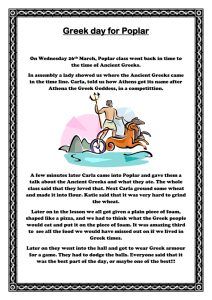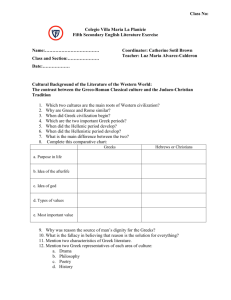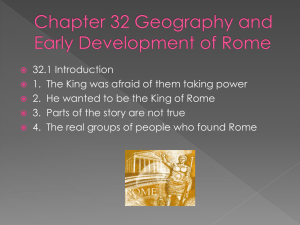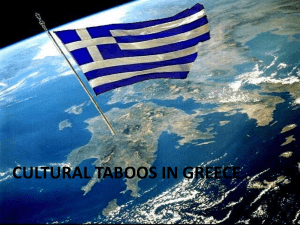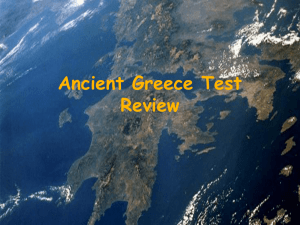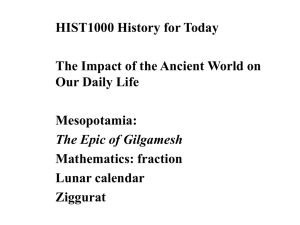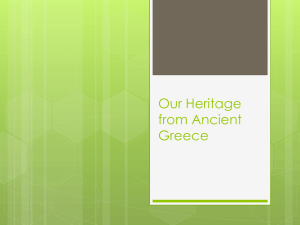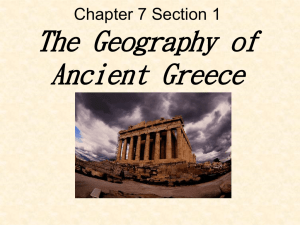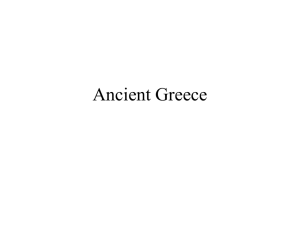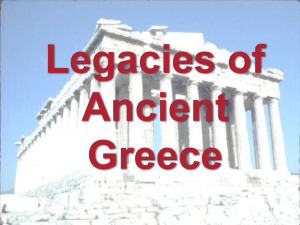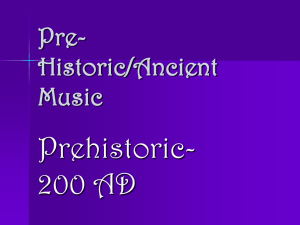Ancient Greece
advertisement
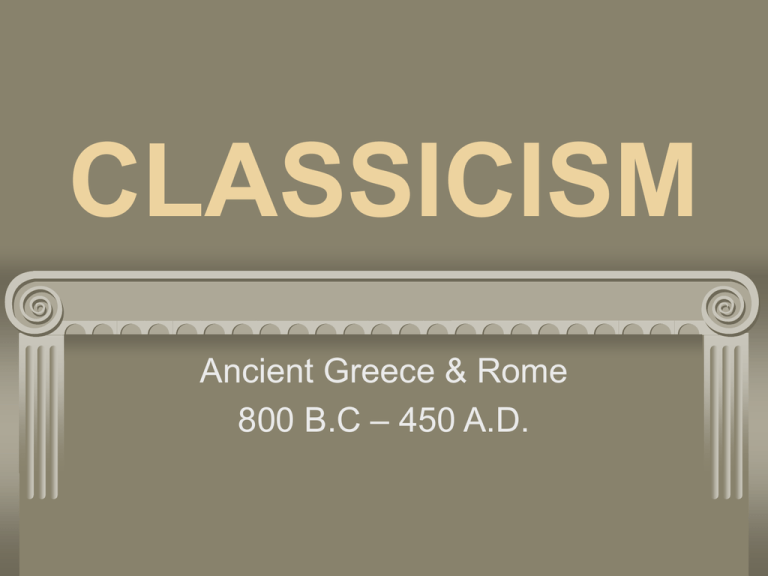
CLASSICISM
Ancient Greece & Rome
800 B.C – 450 A.D.
Philosophy of Art
The arts present the
universal idea of
beauty through logic,
order, reason and
moderation.
The purpose of the arts
is to show perfection
in human form and
structure.
Characteristics of the Arts
Art forms focus on the
humanistic element
“Super human” images
and structures prevail
Stories and dance expand
on emotion
Music is intellectual and
scientific
THE GREEKS
Greek Art
Ancient Greece gave
us the basis for most
of our formal
structures and images
Their ideals have been
the measuring stick by
which other styles
were evaluated
The Devine Ratio: Phi
The concept was first
promoted by the Greek
geometer Euclid
It is based on the
Fibonacci Sequence
{1,1,2,3,5,8,13,21,etc.}
Like Pi, it is an irrational
number {1.618033988…}
We just call it 1.618
More on Phi
It is said to exist in
nature and dictates the
best proportions that
are pleasing to the eye
The Golden Section
This is the geometric
equivalent of Phi
It can be applied to most
works of art to
determine their use of
the Elements of Art
through the Principles of
Design
The Greeks were
masters in its’ use
The Parthenon
The signature structure
of Greek architecture
Innovations include:
post & lintel
construction, sloping
roof, colonnade
A perfect example of
the ideal of Phi
Basis for design of
Washington D.C.
More Parthenon
Built as a temple to the
goddess Athena
Designed to be the
feature building of the
Acropolis
Uses all Elements of
Art in its’ design
How It Probably Looked
The Discus Thrower
Completed by Myron
in 450 B.C.
The best example of
classic Greek
sculpture
Shows the ideal of the
perfect human form
Well developed body
in motion
The Column
Pythagoras – Music Theory
Pythagoras was the first
to experiment with and
discuss the science of
sound
He discovered that two
strings of equal tension
produce the same sound.
When divided in ½ the
shorter string produces
the same pitch 1 octave
higher
Ancient Greek Music
Music was inseparable
from poetry and dance
It was made up of
mostly a simple
melody with
instrumental
accompaniment
Used in story telling
and celebration
Major Instruments
Purposes of Music
To tell stories – Many of
Homer’s tales were
sung to the audience
To dance – either to tell
stories or histories or
convey emotion
To celebrate – The
festivals of the God
Dionysus required
music for merry making
Greek Drama
Drama was a major
source of
entertainment in
ancient Greece
Performances would
last for days usually
organized around
seasonal festivals
Audiences could be as
large as 30,000 people
More Greek Drama
Stories included
tragedies and
comedies
Tragedies: Stories in
which the protagonist
loses
Comedies: Stories in
which the protagonist
wins
Oedipus Rex
Tragedies were quite
popular
One of the most
famous is Oedipus
Rex by Sophocles
It is the story of a man
who kills his father
and marries his mother
to the ruin of all
Medea
Medea by Euripides is
considered the greatest
tragedy and is still
performed today
It tells the story of a
woman scorned by her
husband
She kills him and later
their children in order to
protect them
Drama Basics
Presentation is similar
to that of the Japanese
Noh
All actors are men
Masks are worn to
portray emotion and
character elements
Plots have many twists
and turns
Three Great Playwrights
Literature - Homer
Poet writer of great
epic tales
The Iliad: The story
of the siege of Troy
The Odyssey: The
story of Ulysses’
wanderings
These document many
of the Greek myths
and histories
Plato
Considered the father
of modern thought
Developed the concept
of the modern
Democracy
His writing “The
Republic” is written in
dialogue form to make
his ideas
understandable
Socrates
A contemporary of
Plato’s
Believed in thought
and teaching – ideas
and knowledge are
living things
One should do what is
right even when
universally opposed
Aesop
Thought to be a slave
in the 6th Century B.C.
Wrote fables that told
stories giving a moral
message
Used animals as
human characters
“The Tortoise & the
Hare” is an example
THE ROMANS
Ancient Rome
Rome was the largest
geographic and
strongest political
empire of Europe for
almost 1000 years
While great
innovators, they were
not the creators that
the Greeks were
Roman Art
Because of their
Etruscan heritage, the
Romans were
influenced by the
Greeks
Very interested in
portraits
Focused on reality
more than Greeks
More Roman Art
Later in the history of
the Empire, they used
art as propaganda for
the greatness of Rome
Throughout their
history, they only gave
religion a passing
glace in their art
Innovations
The Romans shared a
love of large decorated
structures with the
Greeks
This lead to
advancements in
building like:
Concrete
Arches
Domes
Aqueducts
Built to supply the city
of Rome with water
When Rome’s
population was 1
million, the aqueducts
supplied 1 cubic meter
per person per day
Arch construction was
used to bridge valleys
The Coliseum
Built as a source of
entertainment for all
Could seat 50,000
spectators
Trap doors in the floor
allowed for different
entrances to the field
A whole city existed
below stage level
Could be flooded for
water battles
Coliseum II
A canopy could be
extended to give the
spectators shade
Home of the famous
gladiator battles
Also battle recreations,
animal fights and
other gruesome games
were seen
The Pantheon
Built as a temple to the
seven deities of the
seven planets
The dome is concrete
and meant to point to
he heavens
The opening is 27 feet
wide and the source of
light
Pantheon II
It’s reflection of the
Parthenon is evident
from the front view
The temple is a perfect
circle capped by the
dome
It is another example
of Phi
Said to be the model
of the US Capitol

